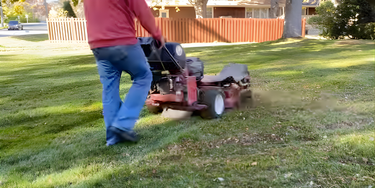Autumn is here and the trees are shedding their leaves. Your yard is entering a critical period that can affect next spring’s growth. Fall yard maintenance isn’t just about keeping things tidy—it’s about giving your lawn and landscape the care they need to rest and regenerate. From deciding whether to rake or mulch those fallen leaves, to giving your grass one last proper mowing, to knowing when to do some dormant pruning, now’s the moment to develop a plan so your outdoor spaces have a healthy, beautiful comeback when warmer days return. Here are some helpful tips from the University of Minnesota Extension Service.
Rake or Mulch
Mulching leaves into your lawn isn’t just sustainable – it’s an effective practice for healthier turfgrass. Mulch regularly when leaves are dry, and double pass for a finer mulch. This enables them to break down quickly and integrate into the lawn and saves you the labor of picking them up.
While mulched leaves do not return as much nitrogen as grass clippings, this still reduces the need for supplemental fertilizer and is a more eco-friendly and cost-effective practice.
In addition to releasing nutrients, decomposing leaves improve soil structure. The improved soil structure leads to better water infiltration, moisture retention, and root growth. It also improves access to nutrients, water, and air.
Leaf mulching is also very effective as a weed preventative as it covers bare spots and inhibits weed seed germination.
But, there’s a point when excessive leaves left on the surface can damage the lawn in the spring. For example, excessive tree leaf residue can promote snow mold damage.
The extension service recommends mulching tree leaves until you can only see about half of the lawn surface. When less than 50% of the lawn is visible, begin bagging the tree leaves to compost them off-site.
Mowing Grass
Should you mow your lawn shorter going into the winter? Extension says it depends. Some of the benefits of mowing your lawn a little shorter:
- Makes collecting tree leaf litter easier.
- Reduces the risk of snow mold diseases.
- Reduces damage from burrowing rodents like voles.
- Helps with dormant seeding.
But they caution not to lower the mowing height too much all at once, and not any lower than 2 inches after mowing. In general, never cut more than one-third of grass height in a single cutting – this might stress the grass plants going into winter.
Wait to Prune!
Fall is not the time to start pruning back your trees and bushes. The best time to prune is in the late winter, just before spring growth starts. This way the fresh wounds are exposed for only a short length of time. Then the new growth begins the wound sealing process.
Pruning at the proper time can avoid certain disease and physiological problems:
Need Help Preparing for Winter?
Let our team help you get your yard ready for the winter, so you have a healthy green lawn in the spring. Contact the experts at Organic Lawns by LUNSETH to take the first step toward a greener, healthier, chemical-free lawn in 2026.



